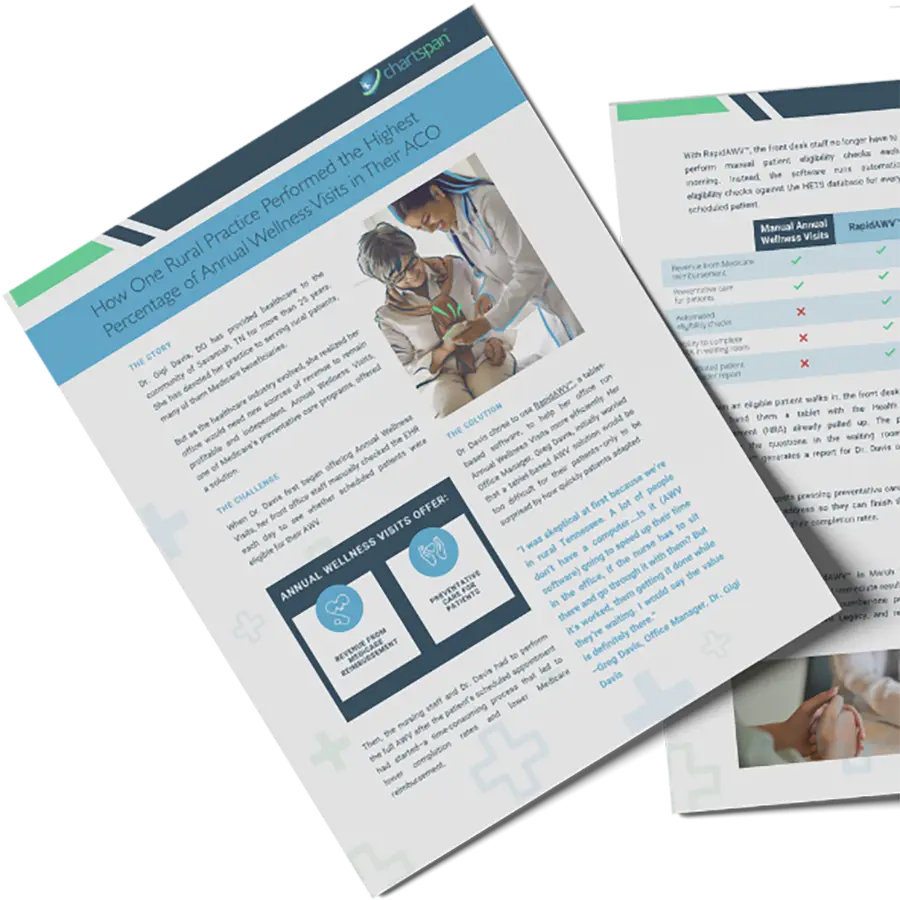
Talk with a ChartSpan Representative Today!
Our team is ready to help you improve patient care and outcomes.
Blog
Why Medicare Wants Providers Performing AWVs
The healthcare industry as a whole has been striving to improve value-based care, and in doing so has created new preventative programs in recent years. In 2011, the Centers for Medicare and Medicaid Services set out to improve preventive care specifically for Medicare beneficiaries by implementing the Medicare Annual Wellness Visit (AWV) program. Although the program has been around for a decade, there are many aspects of the program that are not commonly known, and it is still not yet widely adopted. In this blog, we will explore the foundations of the Medicare Annual Wellness Visit and explain its importance.
What is the AWV?
The Annual Wellness Visit is a preventive service that works to identify risk factors in a patient’s health status. The AWV is a no-cost preventive visit for Medicare beneficiaries but has the opportunity to save hundreds to thousands in healthcare spending through early detection and analyzing risk factors that could contribute to the patient’s decline. Since no coinsurance is required, it is easy for patients to agree to participate.
The Annual Wellness Visit is often confused with the annual physical since the names are so similar. However, they are two very different types of visits. A typical routine physical requires an actual physical exam by a physician. On the other hand, the AWV is a patient health survey and includes a follow-up discussion with a healthcare provider. The questionnaire that the patient completes generates a report for their provider to review and allows the provider to assess risk factors that need addressed. The provider who reviews the report with the patient can be a variety of providers, including but not limited to primary care and certain specialty providers, nurse practitioner, physician, physician assistant, and certified clinical nurse specialist.
What is included in the AWV?
Although the AWV does not include a physical examination, that does not mean it is not robust. The visit starts with the Health Risk Assessment (HRA) which is a thorough, self-reported patient questionnaire. The questionnaire asks the patient a variety of questions about their health, including but not limited to:
- Family history and medical history
- Cognitive impairment
- Functional ability
- Immunizations and medications
- Advanced care planning
In addition, routine measurements like body mass index (BMI) and blood pressure are collected. The remainder of the AWV is completed with a discussion between the patient and his or her healthcare provider. Once the questionnaire is complete, a personalized prevention plan is generated and reports are provided for the patient as well as the provider to review together. The report should notify the provider of any risk factors that need to be addressed or acted upon. Oftentimes, these risk factors can lead to tertiary services or follow-up preventive care. It’s a great way to identify issues that may not have been uncovered during a physical exam. Lifestyle interventions are also encouraged for certain risk factors such as high fall risk or smoking. The generated reports are sharable for current providers as well as caregivers so that patients can use them as a guide for their preventative health.
Who is eligible for the AWV?
Patients with Medicare or Medicare part B are typically eligible for the Annual Wellness Visit. However, this is not the case if they have had their Welcome to Medicare or Initial Preventive Physical Examination (IPPE), in the same year. The AWV can only be performed by one provider per year, so additionally, if the patient has already received the AWV in the same year, they are not eligible for a subsequent AWV. Eligibility can be difficult to keep track of, which is why it’s important to utilize a vendor who can check eligibility in real-time utilizing the HETS database.
Why is the AWV important?
Continuous health education is crucial for the elderly population as they become more prone to illness and decline. If providers want to expedite the shift from volume-based care to value-based care, preventative services like the AWV are critical to improve the quality of care they deliver.
The reports generated during the Annual Wellness Visit are a catalyst to an in-depth conversation between the patient and their provider. During this conversation, the provider is able to address aspects of the patient’s health that may not have been discussed previously, and then the provider can offer health advice or additional services that may be necessary. The risk factors identified in the AWV help notify the healthcare provider of additional services that should be completed. Tertiary services can provide additional preventive care and may result in identifying unknown issues.
Overall, the AWV and appropriate follow-up on risk factors can save patients from health surprises down the road. This not only helps patients stay one step ahead of their health, but it also can reduce future healthcare costs. A patient who receives an AWV improves medical outcomes resulting in $570 less annual Medicare healthcare costs, equal to a 5.7% reduction per patient.* For more information on Annual Wellness Visits, visit ChartSpan’s AWV Solutions Page.
*Retrospective AWV Cohort Study from The American Journal of Managed Care-March 2019. Assumes $10,000 average, per patient, annual benchmark
Subscribe for More Insights
Get valuable resources delivered straight to your inbox.
"*" indicates required fields





